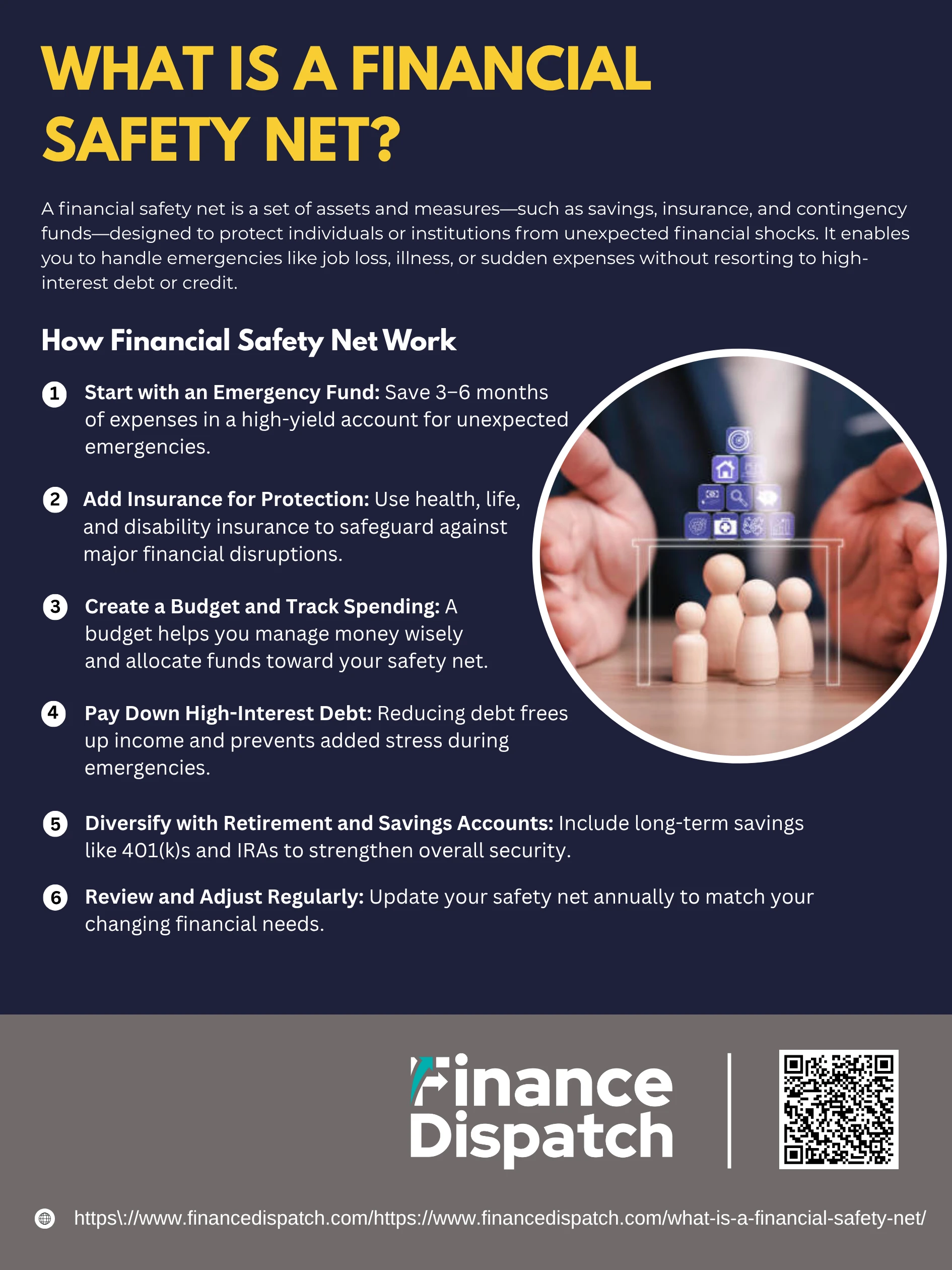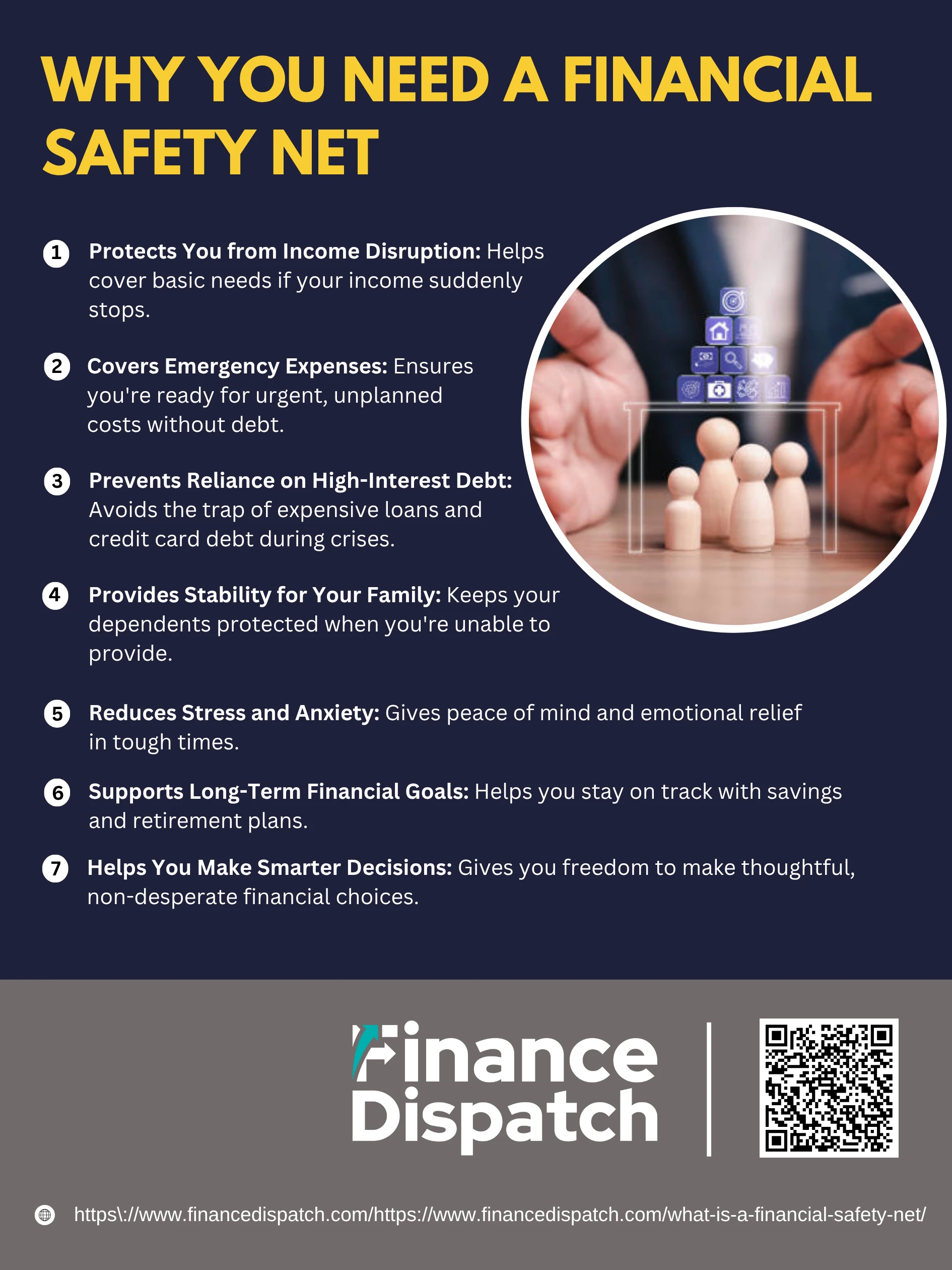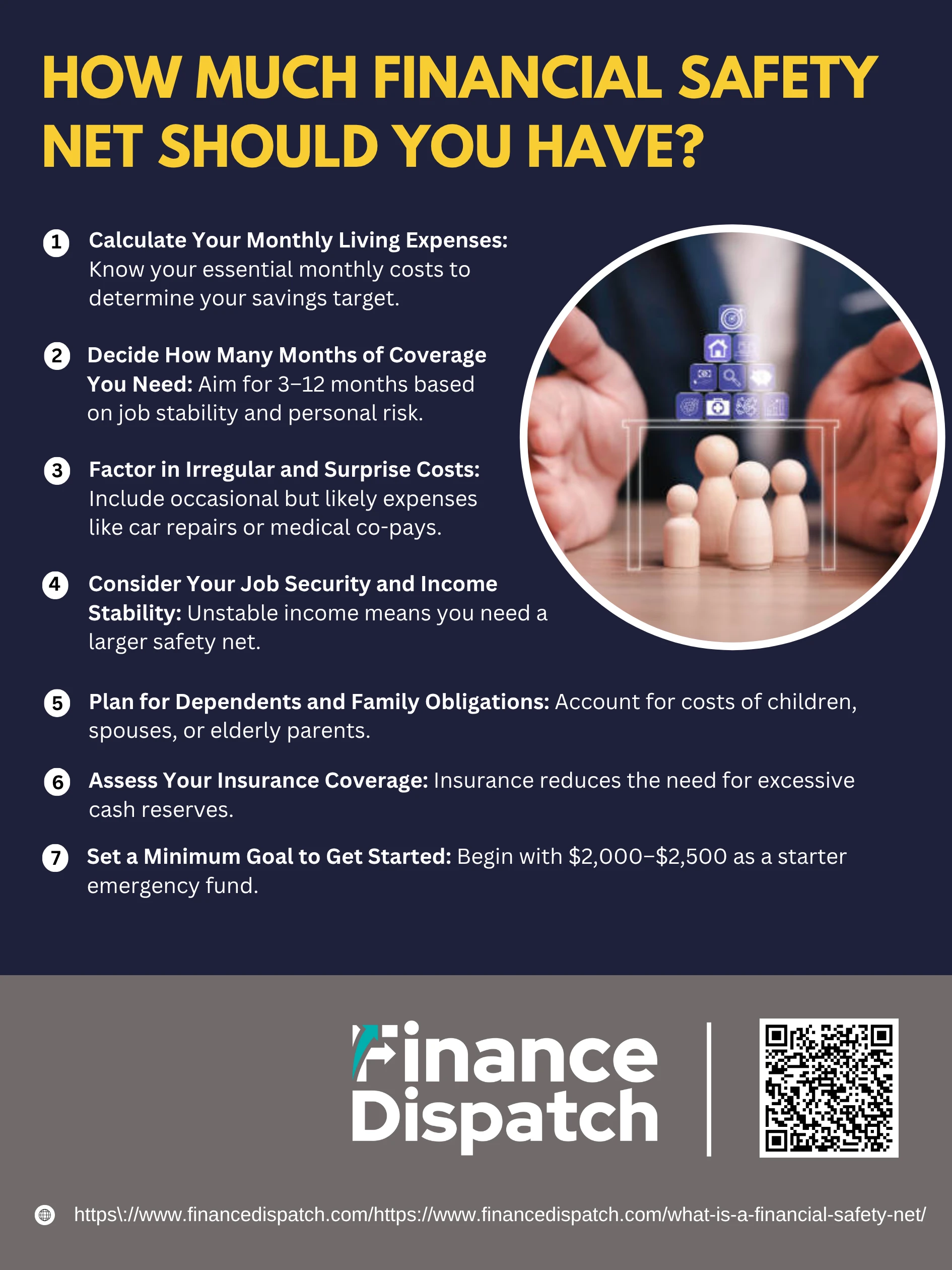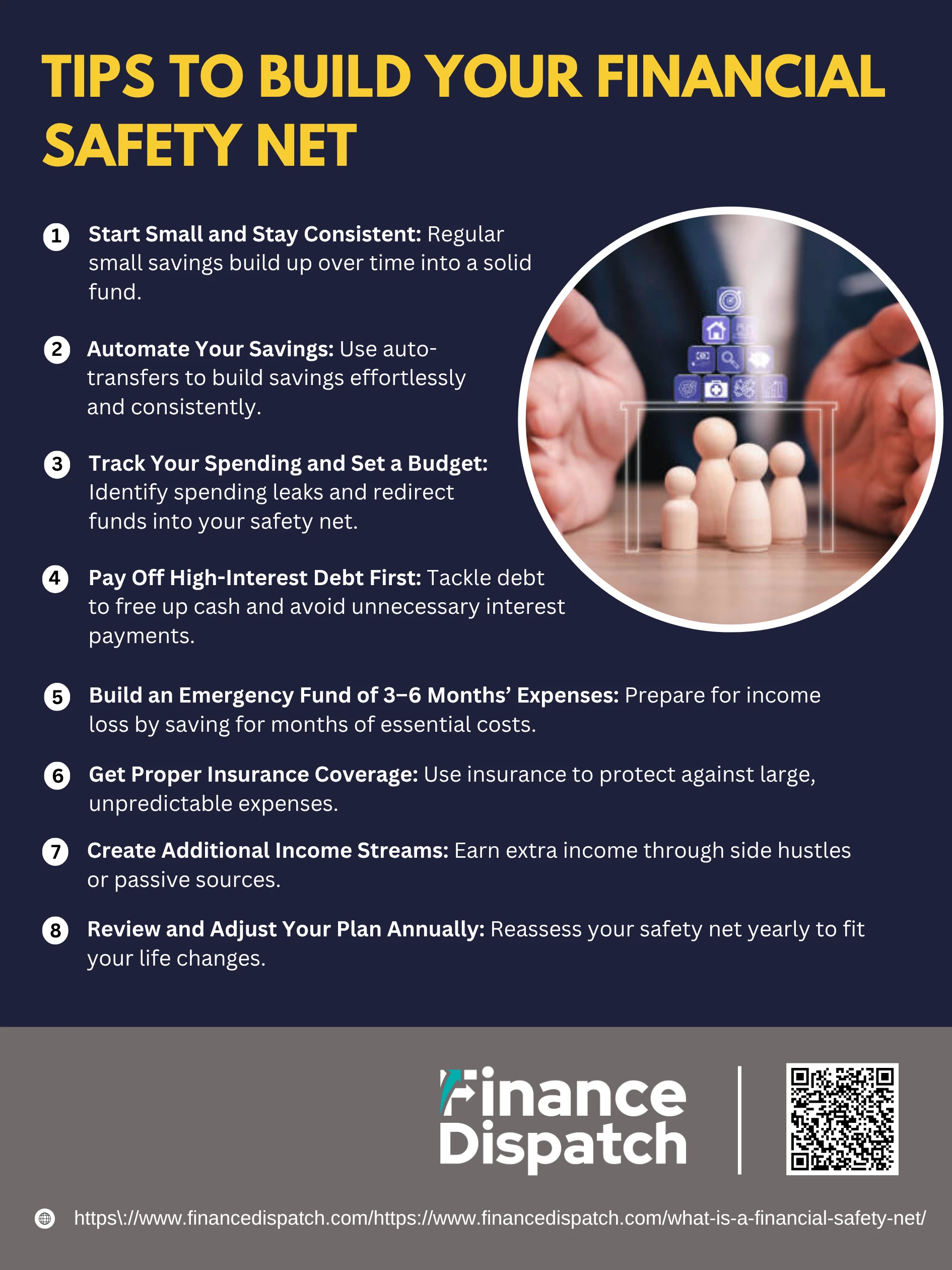Life has a way of throwing curveballs—whether it’s an unexpected job loss, a medical emergency, or a sudden car repair, these financial surprises can quickly derail your stability. Unfortunately, many people aren’t prepared. In fact, studies show that over half of Americans wouldn’t be able to cover a $1,000 emergency without borrowing money or using credit. That’s where a financial safety net comes in. Much like a real net protects you from a fall, a financial safety net offers a cushion that helps you weather life’s storms without sinking into debt or panic. In this article, we’ll explore what a financial safety net is, why it matters, and how to build one that’s right for you.
What Is a Financial Safety Net?
A financial safety net is a collection of resources and tools—such as savings, insurance, and investments—that provide support during times of unexpected financial hardship. It’s designed to catch you when life takes an unforeseen turn, whether that’s losing your job, facing a medical emergency, or dealing with a costly home repair. Rather than relying on credit cards, loans, or borrowing from others, a well-structured safety net gives you the ability to handle these situations with greater confidence and less stress. Think of it as your personal financial backup plan—one that protects your income, your family, and your future goals from being derailed.
 How Financial Safety Net Work?
How Financial Safety Net Work?
A financial safety net functions as a protective barrier against financial instability caused by emergencies or loss of income. It’s not just about saving money—it’s a multi-layered approach that involves thoughtful planning, strategic tools, and consistent habits. Each element works together to keep you financially grounded when life becomes unpredictable.
Here’s how a financial safety net works in more detail:
1. Start with an Emergency Fund
Your emergency fund is the core of your financial safety net. It’s a savings cushion specifically set aside for urgent, unplanned expenses such as medical emergencies, sudden job loss, or essential home repairs. Financial experts recommend saving at least three to six months’ worth of your basic living expenses in an easily accessible account, like a high-yield savings account. This ensures you won’t need to rely on credit cards or loans in moments of crisis.
2. Add Insurance for Protection
While emergency funds help in the short term, insurance offers a deeper layer of security for larger, longer-term financial disruptions.
- Disability insurance provides income if you’re unable to work due to illness or injury.
- Health insurance helps cover expensive medical treatments.
- Life insurance ensures your family or dependents can stay financially stable in the event of your death.
3. Create a Budget and Track Spending
A detailed budget helps you understand where your money goes each month and ensures you’re living within your means. When you track your spending, you can identify unnecessary expenses and redirect that money into your safety net. Budgeting also makes it easier to stay consistent with your financial goals and avoid unexpected shortfalls.
4. Pay Down High-Interest Debt
High-interest debts—especially from credit cards—can erode your financial security quickly. In an emergency, the added burden of interest payments can make it harder to recover. By paying off or significantly reducing this kind of debt, you free up more of your income to go toward savings, insurance, and other essential components of your safety net.
5. Diversify with Retirement and Savings Accounts
A well-rounded financial safety net includes long-term tools like 401(k)s, IRAs, and other investment accounts. These don’t serve immediate emergencies, but they protect your future by ensuring you’re not financially vulnerable in retirement. Diversifying across savings and investment vehicles also gives you options if you ever need to tap into funds during prolonged financial hardship.
6. Review and Adjust Regularly
Your financial needs and responsibilities change over time—whether due to a new job, a baby, increased rent, or rising healthcare costs. It’s important to review your financial safety net at least once a year. This includes updating your emergency fund amount, reassessing your insurance coverage, and ensuring your savings and investment strategies still align with your current lifestyle.
 Why You Need a Financial Safety Net
Why You Need a Financial Safety Net
Life is unpredictable. One day you’re doing fine financially, and the next, a medical emergency, job loss, or unexpected home repair could throw everything off balance. Without a plan in place, these surprises can quickly lead to debt, stress, and long-term financial damage. That’s why having a financial safety net is more than just a smart move—it’s a necessity. It acts as a personal buffer, shielding you and your loved ones from the ripple effects of life’s disruptions.
Here are the top reasons why you need a financial safety net:
1. Protects You from Income Disruption
If your paycheck suddenly stops—whether due to layoffs, reduced hours, or a business slowdown—your safety net gives you time to recover without panicking. It helps you maintain basic living expenses like rent, groceries, and transportation while you search for a new job or explore alternative income sources.
2. Covers Emergency Expenses
Emergencies never wait until you’re financially ready. From a burst pipe to a last-minute flight for a family emergency, these unplanned costs can be overwhelming. A safety net ensures you’re not forced to dip into credit or borrow money in high-pressure moments.
3. Prevents Reliance on High-Interest Debt
Without savings to fall back on, many people rely on credit cards, payday loans, or personal loans during crises. These options often come with high interest rates and can lead to a vicious debt cycle that’s difficult to escape. A financial safety net helps you avoid this trap.
4. Provides Stability for Your Family
If you’re supporting a family, your financial responsibilities don’t stop when trouble hits. A financial safety net—especially when it includes life and disability insurance—can ensure your loved ones are still cared for even if you can’t provide for them temporarily or permanently.
5. Reduces Stress and Anxiety
One of the most underrated benefits of a safety net is the peace of mind it brings. Financial stress is one of the leading causes of anxiety and relationship conflict. Knowing you have a plan can help you stay calm and focused, even during hard times.
6. Supports Long-Term Financial Goals
When you don’t have a safety net, emergencies can force you to drain your retirement account, halt your home down payment savings, or cancel other financial plans. A safety net acts as a buffer, helping you stay on track with your goals even when life gets messy.
7. Helps You Make Smarter Decisions
Financial security brings freedom. With a safety net, you’re not pressured to take the first job offer, make risky investments, or stay in toxic situations just for money. You gain flexibility and time to make thoughtful, strategic decisions instead of reacting out of fear or desperation.
Key Components of a Solid Financial Safety Net
A strong financial safety net isn’t built on one single solution—it’s made up of multiple layers working together to protect you from life’s financial surprises. Each component plays a unique role in helping you weather emergencies, reduce risk, and maintain stability. From quick-access savings to long-term insurance policies, combining these tools creates a foundation of resilience that can carry you through uncertain times.
Here’s a breakdown of the key components of a solid financial safety net:
| Component | Purpose |
| Emergency Fund | Covers urgent and unexpected expenses like car repairs or job loss. |
| Disability Insurance | Replaces a portion of your income if you’re unable to work due to illness or injury. |
| Life Insurance | Provides financial support to your dependents if you pass away. |
| Health Insurance | Protects you from overwhelming medical bills and ensures access to care. |
| Retirement Savings | Ensures long-term financial stability during your post-working years. |
| Cash Reserves | Offers quick liquidity for minor or short-term needs, separate from your main savings. |
| Debt Management Plan | Reduces financial burden by minimizing high-interest debt and freeing up income. |
| Estate Plan | Organizes your assets and protects your beneficiaries from legal or financial complications. |
 How Much Financial Safety Net Should You Have?
How Much Financial Safety Net Should You Have?
There’s no one-size-fits-all answer when it comes to how much you need in your financial safety net. The right amount depends on your lifestyle, income stability, family situation, and monthly expenses. What’s important is having enough saved or protected so that you can cover basic needs without falling into debt if life takes an unexpected turn. Whether you’re single, have dependents, or are self-employed, calculating your safety net thoughtfully can help you avoid financial strain and buy you peace of mind.
Here’s how to determine how much of a financial safety net you should have:
1. Calculate Your Monthly Living Expenses
Begin by tracking all your essential spending. This includes housing costs (rent or mortgage), utilities, food, transportation, insurance premiums, loan payments, and any recurring necessary bills. Don’t include entertainment, dining out, or luxury purchases—this is about survival, not comfort. Knowing this baseline gives you the foundation for building your safety net.
1. Decide How Many Months of Coverage You Need
Once you have your monthly total, multiply it by the number of months you want your safety net to cover.
- 3 months may be sufficient if you’re single, rent your home, and have a stable job.
- 6 months is ideal for most people, offering enough time to recover from job loss or a medical emergency.
- 9–12 months is recommended for freelancers, business owners, or anyone with an unpredictable income.
2. Factor in Irregular and Surprise Costs
Life isn’t just rent and groceries. Build in some cushion for non-monthly but likely expenses:
- Car maintenance and repairs
- Medical co-pays or prescriptions
- Pet emergencies
- Appliance replacements
3. Consider Your Job Security and Income Stability
If you’re in a high-risk industry, on commission-based income, or self-employed, your income could drop without warning. In these cases, it’s wise to build a larger safety net—closer to 9 or even 12 months of expenses. The more uncertain your income, the more protection you’ll need.
5. Plan for Dependents and Family Obligations
Do you support children, a spouse, or elderly parents? If so, your emergency fund should cover not only your expenses but theirs too. You may need to factor in school fees, medical costs, childcare, or caregiving services. The more people rely on you, the more robust your financial safety net should be.
6. Assess Your Insurance Coverage
Strong insurance can offset your need for cash savings.
- Health insurance reduces the need for large out-of-pocket medical funds.
- Disability insurance provides income if you’re unable to work.
- Life insurance protects your family if something happens to you.
7. Set a Minimum Goal to Get Started
If building 6 or 12 months of expenses feels impossible right now, start small. Aim to save $2,000 to $2,500 as a short-term buffer. This amount can cover minor emergencies and prevent you from taking on high-interest debt. Once that’s in place, continue growing it steadily with automated transfers or windfalls like tax refunds or bonuses.
 Tips to Build Your Financial Safety Net
Tips to Build Your Financial Safety Net
Building a financial safety net is one of the smartest and most empowering things you can do for your future. It gives you the confidence to face emergencies without relying on high-interest debt, helps you stay afloat during tough times, and supports your long-term financial goals. The process doesn’t require a large income or a financial background—it requires commitment, consistency, and a few key strategies. Whether you’re just starting out or looking to strengthen your existing safety net, the following tips will help you lay the foundation for financial stability.
Here are practical and detailed tips to help you build your financial safety net:
1. Start Small and Stay Consistent
If the idea of saving thousands of dollars feels intimidating, remember that every great plan begins with a single step. Start with small, manageable amounts—even $10 to $50 per week. What matters most is consistency. Over time, these small deposits grow into a reliable cushion. The earlier you begin, the more time your savings has to grow through compounding interest or regular contributions.
2. Automate Your Savings
The best way to ensure you’re saving regularly is to automate it. Set up an automatic transfer from your checking account to a separate savings or emergency fund every payday. This “set it and forget it” approach removes the temptation to skip savings and builds discipline into your routine. For more structure, consider using banking apps that round up your purchases and deposit the difference into savings.
3. Track Your Spending and Set a Budget
Understanding your spending habits is essential for finding savings opportunities. Use budgeting tools or mobile apps like Mint, YNAB, or your bank’s budgeting dashboard to see where your money is going. Categorize your expenses into needs, wants, and extras. Once you identify areas where you overspend—like dining out or subscriptions—you can redirect that money into your safety net instead.
4. Pay Off High-Interest Debt First
Debt with high interest, especially credit card balances, can quickly erode your financial foundation. While building your safety net, aim to simultaneously reduce this debt. Prioritize minimum emergency savings first (e.g., $500–$1,000), then aggressively tackle high-interest debt. Once your debts are under control, you can redirect those payments into savings instead of interest.
5. Build an Emergency Fund of 3–6 Months’ Expenses
Your emergency fund is the heart of your financial safety net. It should be large enough to cover three to six months of essential living expenses, including rent, utilities, groceries, insurance, and debt payments. This fund helps you survive financially during periods of unemployment, illness, or other unexpected disruptions. Keep it in a high-yield savings account for easy access and better interest growth.
6. Get Proper Insurance Coverage
No amount of savings can prepare you for all types of emergencies. That’s where insurance comes in. Make sure you have adequate coverage for health, disability, life, and property (renters or homeowners). These policies prevent one emergency—like an injury, car accident, or natural disaster—from wiping out your savings. Disability insurance, in particular, is often overlooked but can replace your income if you’re unable to work for an extended time.
7. Create Additional Income Streams
The more income you have, the faster you can build your financial cushion. Explore side hustles like freelancing, consulting, tutoring, selling digital products, or ride-sharing. Even small earnings from hobbies or part-time work can significantly boost your savings. Over time, passive income sources—such as dividends, interest, or rental income—can also supplement your safety net.
8. Review and Adjust Your Plan Annually
As your life changes, so should your financial safety net. Revisit your budget, insurance coverage, and savings goals at least once a year—or whenever you experience a major life event such as a new job, having a child, or buying a home. Adjust the amount you save and the protections you have in place to ensure your safety net always reflects your current needs.
Top Expenses Your Safety Net Should Cover
Your financial safety net exists to protect you from the impact of sudden and unexpected costs. But not all emergencies are the same, and knowing what types of expenses to plan for can help you build a safety net that’s both practical and effective. From essential living costs to surprise medical bills, your safety net should be tailored to cover the most likely and most damaging financial shocks in your life.
Here are the top expenses your safety net should be prepared to cover:
1. Rent or Mortgage Payments
Housing is a non-negotiable expense. Your safety net should ensure you can continue making rent or mortgage payments to avoid eviction or foreclosure during a financial emergency.
2. Utility Bills
Electricity, water, gas, and internet are critical for day-to-day living. Your emergency fund should cover these recurring bills to keep your home functioning smoothly.
3. Groceries and Essential Supplies
You’ll still need to eat and maintain basic household needs. Be sure your safety net includes funds for food, toiletries, and other everyday essentials.
4. Medical Expenses
Even with insurance, out-of-pocket medical costs can be steep. Your safety net should help cover deductibles, co-pays, prescriptions, or urgent care costs.
5. Car Repairs and Transportation
Whether it’s maintaining your vehicle or affording alternative transportation, reliable mobility is crucial—especially if you need to commute for work or emergencies.
6. Childcare and Education
If you have children, unexpected changes in income shouldn’t disrupt their care or schooling. Include enough to cover daycare, tuition, or school-related expenses.
7. Insurance Premiums
To keep your coverage active, plan for continued payment of health, auto, life, and home/renter insurance premiums during times when income may stop temporarily.
8. Debt Payments
Missing loan or credit card payments can damage your credit score. Your safety net should include at least the minimum payments to stay current on debt obligations.
9. Pet Emergencies
Vet visits and treatments for pets can be surprisingly costly. If you’re a pet owner, factor in unexpected pet care expenses as part of your safety planning.
10. Unexpected Travel
Emergencies like a family illness or funeral may require last-minute travel. Your safety net should be flexible enough to handle these urgent trips if needed.
The Consequences of Not Having a Safety Net
Without a financial safety net, even a minor emergency can spiral into a major crisis. A sudden car repair, job loss, or medical bill can force you to rely on high-interest credit cards, personal loans, or borrowing from friends and family—leading to debt that’s hard to escape. The stress of not having money to cover essential needs like rent, food, or utilities can quickly affect your mental and emotional well-being. In the absence of a safety net, you may have to delay important life goals, drain retirement savings, or make desperate financial decisions just to stay afloat. Ultimately, not having a safety net leaves you vulnerable to financial instability, prolonged recovery time, and reduced control over your future.
Difference Between Cash Reserve and a Safety Net
While often used interchangeably, a cash reserve and a financial safety net serve different purposes in your overall financial strategy. A cash reserve is a short-term pool of funds, readily available for immediate or minor needs—like unexpected bills or temporary cash flow issues. A financial safety net, on the other hand, is a broader system designed to protect you from larger and more prolonged financial disruptions. It may include cash reserves, but also combines emergency funds, insurance, and other financial tools. Understanding the difference between the two helps you prepare more effectively for both everyday surprises and serious life events.
Here’s a breakdown of how they differ:
| Aspect | Cash Reserve | Financial Safety Net |
| Purpose | Covers small, short-term expenses | Protects against major, long-term financial disruptions |
| Access | Immediately accessible | May include both liquid and long-term resources |
| Typical Use | Minor emergencies (e.g., car repair, medical co-pay) | Major life events (e.g., job loss, disability, death) |
| Size | Usually a few hundred to a few thousand dollars | Typically covers 3–12 months of living expenses |
| Includes | Cash in checking or savings account | Emergency fund, insurance policies, retirement savings, investments |
| Duration of Support | Days to a couple of weeks | Weeks to several months or longer |
| Goal | Prevent cash flow interruptions | Provide financial security and long-term resilience |
Conclusion
A well-structured financial safety net is essential for navigating life’s uncertainties with confidence and stability. It protects you from unexpected expenses, income disruptions, and long-term setbacks by combining savings, insurance, and smart financial habits. Whether you’re just starting to build your emergency fund or refining your existing safety plan, every step you take toward creating a safety net strengthens your financial resilience. In a world where surprises are inevitable, having a safety net means you’re not only prepared—but empowered to face challenges without losing your footing.



